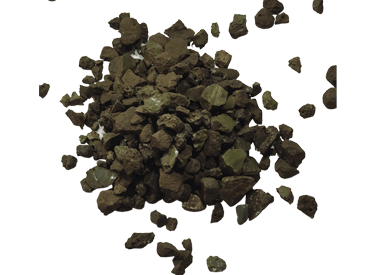Manganese Dioxide Supplier: Explore Our Wide Selection of Industrial Grades

As a leading supplier and importer of manganese dioxide from different parts of the world, we cater to global demands. Our comprehensive range of manganese dioxide is produced to a high standard of purity, ensuring a contamination-free composition without the inclusion of any additives. This makes it ideally suited for purification and filtration processes requiring the removal of iron and manganese from potable water, as well as applications necessitating high catalytic activity.
What Is Manganese Dioxide
Manganese dioxide (MnO₂) is an inorganic compound that occurs naturally as the mineral pyrolusite, which is the principal ore of manganese. It’s not “made of” other materials in a synthetic sense, but rather extracted and processed from the earth. The basic components are one manganese atom and two oxygen atoms bonded together.
However, commercially available manganese dioxide comes in various grades and forms depending on the production method, which influences its physical and chemical characteristics. These grades are broadly categorized as:
Electrolytic Manganese Dioxide (EMD): This high-purity synthetic form is produced by the electrolysis of manganese sulfate solutions. EMD has a well-defined crystal structure (typically γ-MnO₂) and excellent electrochemical activity, making it particularly suitable for battery applications.
Natural Manganese Dioxide (NMD): This is the mined form of pyrolusite. It often contains impurities and its performance characteristics can vary depending on the source. It may undergo some beneficiation processes like crushing, grinding, and washing.
Chemical Manganese Dioxide (CMD): This is a synthetic form produced through chemical reactions, typically involving the reduction of permanganate salts or the oxidation of lower manganese oxides. CMD generally exhibits higher purity and more controlled physical properties (like particle size and surface area) compared to NMD.
Applications Of Manganese Dioxide
Manganese dioxide’s versatile properties, particularly its strong oxidizing ability and catalytic activity, make it suitable for a wide range of applications:
- Batteries: The largest application is in dry-cell batteries (zinc-carbon and alkaline), where it acts as a depolarizer, preventing the buildup of hydrogen gas at the cathode and maintaining the battery’s performance. It’s also a key component in lithium-ion battery cathodes.
- Water Treatment: MnO₂ is used as a filtration medium to remove dissolved iron, manganese, arsenic, and heavy metals from water supplies through oxidation and adsorption. It also catalyzes the decomposition of hydrogen peroxide.
- Chemical Synthesis: It serves as a strong oxidizing agent in various organic and inorganic chemical reactions, used in the production of dyes, pharmaceuticals, and other chemicals. It can oxidize alcohols, aldehydes, amines, and other organic compounds.
- Catalyst: MnO₂ acts as a catalyst in the decomposition of hydrogen peroxide to produce oxygen, and in the production of chlorine gas from hydrochloric acid. It’s also used in catalytic converters.
- Pigment and Colorant: It is used as a pigment in ceramics, glassmaking (to remove the green tint caused by iron impurities and to produce amber or black colors), and paints.
- Steel Production: Manganese dioxide is used in the production of ferromanganese alloys, which are essential in steelmaking for deoxidation and improving hardness and strength.
- Other Applications: It finds use in gas masks (as an absorbent for carbon monoxide), the rubber industry (to increase viscosity), and in the production of certain fertilizers and animal feed.
Characteristics And Description
Manganese dioxide (MnO₂) is a blackish-brown solid that is practically insoluble in water. It is an amphoteric oxide, meaning it can exhibit both acidic and basic properties, although its basicity is weak. It is a strong oxidizing agent, readily accepting electrons from other substances, especially in acidic conditions.
Different grades of MnO₂ exhibit variations in:
- Purity: EMD generally has the highest purity, followed by CMD, with NMD typically having the lowest.
- Crystal Structure: Different production methods lead to various crystalline forms (polymorphs) of MnO₂, such as α, β, γ, δ, and ε, each with slightly different properties and performance characteristics, particularly in electrochemical applications.
- Surface Area and Porosity: These factors influence the reactivity and adsorption capacity of MnO₂. Synthetic grades often have higher surface areas.
- Particle Size and Morphology: These properties are crucial for applications like battery cathodes and catalysis, affecting the electrode kinetics and reaction efficiency.
Manganese dioxide is relatively stable under normal conditions but will decompose upon heating to higher temperatures, releasing oxygen. It reacts with acids, particularly concentrated hydrochloric acid, to produce chlorine gas. While essential in many industrial processes, inhalation of manganese dioxide dust or fumes can be harmful and should be avoided. Overall, manganese dioxide is a crucial inorganic compound with diverse applications stemming from its unique chemical and physical properties, and the specific grade used is carefully chosen based on the requirements of the intended application.
Reduce your operational expenses through extended media lifespan, lower energy consumption, and decreased disposal costs. Our high-performance solutions offer exceptional value, maximizing your investment without compromising on effectiveness. Choose smart, choose sustainable, choose us for cost-efficient operations.
